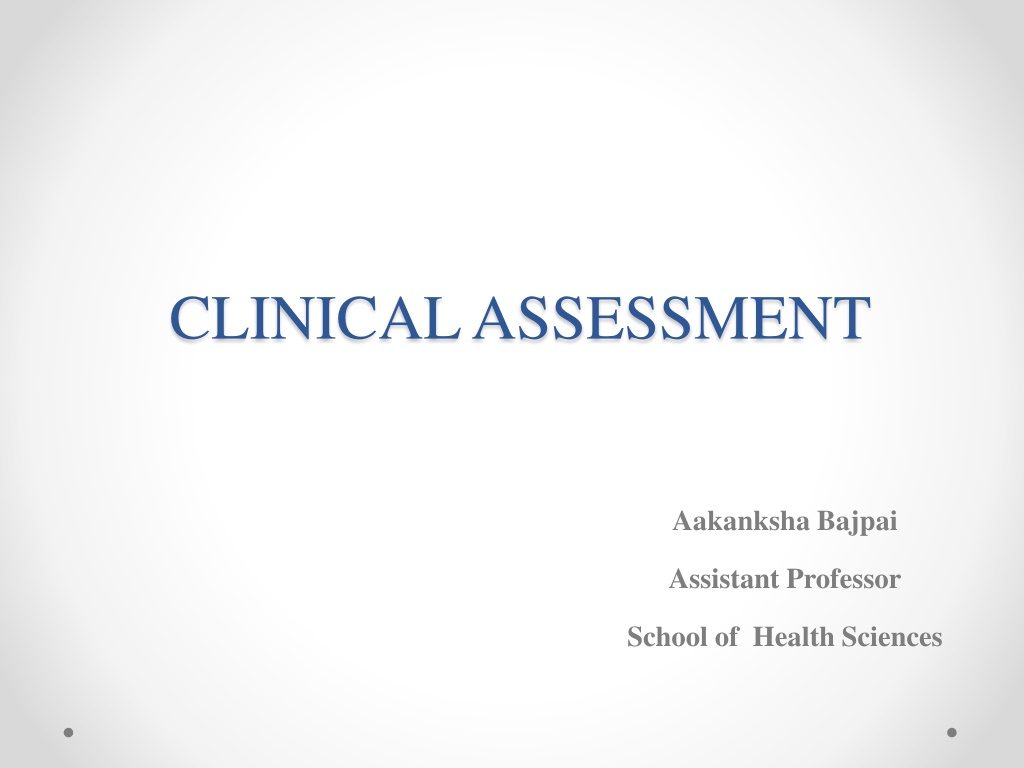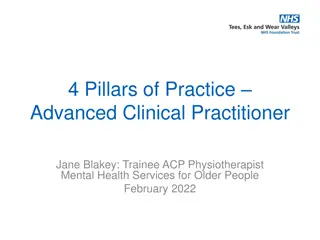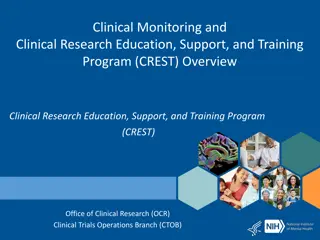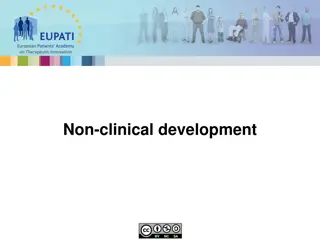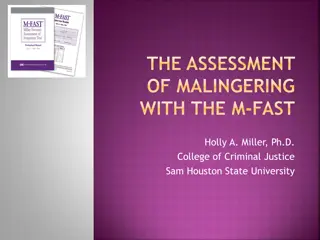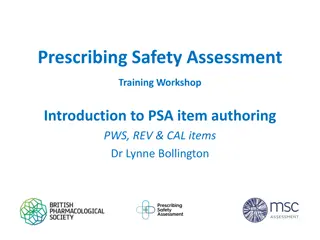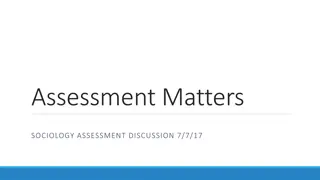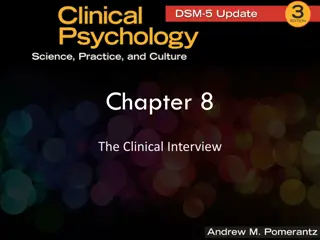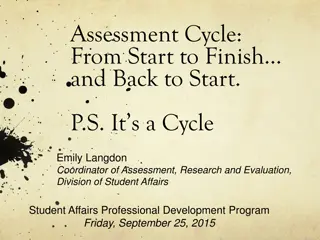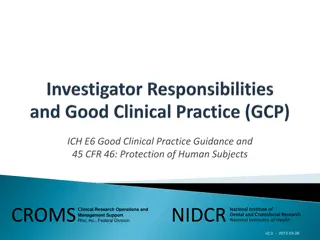Clinical Assessment Process and Purpose
Clinical assessment is the systematic collection of patient data to identify health status, problems, and treatment needs. It involves evaluating subjective and objective data to establish priorities, determine etiology, and assess risks for complications. Techniques like open-ended questions are used to communicate effectively and gather detailed patient information for tailored care plans.
Download Presentation

Please find below an Image/Link to download the presentation.
The content on the website is provided AS IS for your information and personal use only. It may not be sold, licensed, or shared on other websites without obtaining consent from the author.If you encounter any issues during the download, it is possible that the publisher has removed the file from their server.
You are allowed to download the files provided on this website for personal or commercial use, subject to the condition that they are used lawfully. All files are the property of their respective owners.
The content on the website is provided AS IS for your information and personal use only. It may not be sold, licensed, or shared on other websites without obtaining consent from the author.
E N D
Presentation Transcript
CLINICAL ASSESSMENT Aakanksha Bajpai Assistant Professor School of Health Sciences
Clinical Assessment Assessment is the process of collecting clinical information about the patient s health status. The evaluation of the data and identification of the specific problems and needs of the patients. The development of a treatment plan that can be managed by the health care provider.
Purpose of Assessment The purpose of assessment may include any of the following:- 1)To obtain a base line data about the patient s physical and mental status. 2)To supplement or verify any previous data. 3)To identify actual and potential problems. 4)To obtain data that will help the practitioner established a assessment and treatment plan. 5)To focus on specific problems.
6)To determine immediate needs and to establish priorities. 7)To determine the etiology of the problem. 8)To determine any related or contributing factors can. 9)To identify patients strength. 10)To identify the risk for complication.
Types of Data Clinical information that is provided by the patient that can not be observed directly is called subjective data. Characteristics about the patient that can be observed directly by the practitioner are called objective data.
Techniques of Communication Verbal techniques of communication used by the examiner to facilitate the interview may include: Open ended question Closed ended question.
Open Ended Question An open ended question ask the patient to provide narrative information. The following are examples of open ended question. Example:- What brings you to OPD today ? Tell me why have you come to OPD? Can you describe what your breathing has been like today? You said that you have been short of breath tell me more! The open ended question is unbiased it allows the patient s freedom to answer in any way this type of questions encourages the patient to respond at greater length and give a spontaneous account of the condition. As the patient answers, the examiner should stop and listen.
Closed Ended Question A closed ended question asks the patient for the specific information . This type of question elicits a short or one or two word answer, a YES/NO, or a forced choice. Close ended questions speed up the interview.
Symptoms:-Asymptom is something that the patient experiences or feels. Example- stiffness, dizziness, numbness, pain. Sign:-A sign is something that is found by an examiner and is more likely to be discovered during the physical test and measure. Example- swelling, discoloration & muscle atrophy.
Red flag They are defined as findings during the patient interview or in physical examination that may be associated with serious medical conditions such as systemic or local infection, spinal cord compression, fracture. Red flags sometimes require immediate and further investigation and may a referral to a medical professional. The presence of a single red flag is usually not cause for immediate medical attention although it should be considered in the context of the patient as a whole. Yellow Flag It can be thought of a finding that signals proceed with caution .
General Demographics This category includes patients name, age, gender, address, occupation and date of assessment. Chief Complaint The Chief complaint of the patient is the reason for being evaluated by a physiotherapist. The patient s chief complain should include onset duration and characteristics of the sign and symptoms. It is not uncommon for patient to have more than one chief complain if this is the case, you should ask the patient to prioritize the condition of concern, as it is often quite difficult to effectively address more than one condition in initial visit.
Patient History The purpose of the patient history is to gather subjective & objective data which in turn can be used to develop a more complete picture of the patient s post and present health. History of present illness (HOPI) HOPI should include question about how and when the condition begin this is considered the mechanisms of injury or the mechanism of onset(mechanism of injury). Example:- 1)Would you describe when and how the pain started? 2)Can you please tell me the details of how you were injured . 3)Can you think of any reason why this problem may have started?
4)Did you have any illness, fall or accidental month or two before the problem started? 5)Did the pain begin suddenly or gradually over several days or weeks? Past medical History Past health including childhood illness, accident or injury, serious or chronic illness hospitalization, immunization vaccination allergy. It is appropriate to ask about the presence of condition such as diabetes mellitus, hypertension, asthma, thyroid. Example:-1)Do you have any ongoing medical condition that you are being treated for? 2)Have you ever been diagnosed with diabetes, hypertension, asthma, thyroid.
Surgical History Date of surgery Type of surgery Type of implant Family history A patient s family medical history is always important when screening for disease but may or may not be relevant to the patients current condition.
Personal History Assessing a patient s health and habit can reveal activity or factor not yet discussed that may positively or negatively affect the patient s health as well as the physiotherapy related condition this may include alcohol consumption, smoking of elicit drug. Example:-1)do you smoke? If yes, How many pack everyday? 2)Do you consume alcohol ? If yes , How many drinks per week? 3)Have you ever used alcohol to decrease your pain?
Social History Surroundings Socio-economic status Vital signs Body temperature Blood pressure Heart rate Respiratory rate(12-20 breath/min) SpO2. Note-Males- Abdominothoracic breaths(9 % diaphragm large than female) Females- Thoracoabdominal breaths.
On Observation Weight Height BMI Body built Posture Swelling Deformity Contracture Scar Gait
On Examination Range of motion(ROM) Manual muscle testing (MMT) Limb Length Tenderness Pain Assessment Onset Intensity Nature Relieving Factors Aggravating Factors
Provisional diagnosis Not 100% sure of diagnosis More information is needed Differential diagnosis More than one possibility for your diagnosis Investigations Xray MRI CT scan Blood test. Special Tests
Confirmed Diagnosis Treatment Plan Short term goals Long term goals Final Outcome PT management Electrotherapy Exercise therapy
